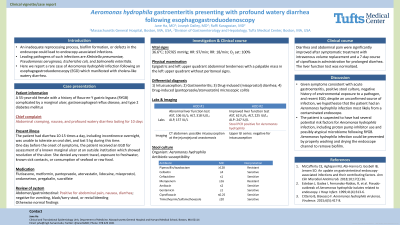Back


Poster Session C - Monday Afternoon
Category: General Endoscopy
C0308 - Aeromonas hydrophila Gastroenteritis Presenting With Profound Watery Diarrhea Following Esophagogastroduodenoscopy
Monday, October 24, 2022
3:00 PM – 5:00 PM ET
Location: Crown Ballroom

Has Audio

Jane Ha, MD
Korea University College of Medicine
Boston, MA
Presenting Author(s)
Jane Ha, MD1, Joseph Dailey, MD2, Raffi Karagozian, MD2
1Korea University College of Medicine, Seoul, Seoul-t'ukpyolsi, Republic of Korea; 2Tufts Medical Center, Boston, MA
Introduction: An inadequate reprocessing process, biofilm formation, or defects in the endoscope could lead to endoscopy-associated infections. Leading pathogens of such infections are Klebsiella pneumoniae, Pseudomonas aeruginosa, Escherichia coli, and Salmonella enteritidis. Here we report a rare case of Aeromonas hydrophila infection following an esophagogastroduodenoscopy (EGD) which manifested with cholera-like watery diarrhea.
Case Description/Methods: A 55-year-old female with a history of Roux-en-Y gastric bypass (RYGB) complicated by a marginal ulcer, gastroesophageal reflux disease, and type 2 diabetes mellitus presented with 10 days of abdominal cramping, nausea, and profound watery diarrhea. The patient had diarrhea 10-15 times a day, including incontinence overnight, was unable to tolerate an oral diet, and lost 5 kg during this time. One day before the onset of symptoms, the patient received an EGD for assessment of a known marginal ulcer at an outside institution which showed resolution of ulcer. She denied any recent travel, exposure to freshwater, known sick contacts, or consumption of seafood or raw food. Physical examination was significant for epigastric and left upper quadrant abdominal tenderness with a palpable mass in the left upper quadrant without peritoneal signs. Labs were significant for elevated aminotransferases (AST, 106 IU/L; ALT, 318 IU/L) and alkaline phosphatase (157 IU/L) which later decreased during the hospital course. CT abdomen revealed possible intussusception at the jejunojejunal anastomosis, while the upper GI series was negative for the intussusception on the second day of admission. Stool culture was positive for Aeromonas hydrophila. Symptoms significantly improved after symptomatic treatment with intravenous volume replacement and a 7-day course of ciprofloxacin administration for prolonged diarrhea.
Discussion: Given symptoms consistent with acute gastroenteritis, positive stool culture, negative history of environmental exposure to a pathogen, and recent EGD, despite an unconfirmed source of infection, we hypothesize that the patient had an Aeromonas hydrophila infection most likely from a contaminated endoscope. The patient is suspected to have had several potential risk factors for Aeromonas hydrophila infection, including proton pump inhibitor use and possibly atypical microbiome following RYGB. Aeromonas hydrophila infection could be prevented by properly washing and drying the endoscope channel to remove biofilm.
Disclosures:
Jane Ha, MD1, Joseph Dailey, MD2, Raffi Karagozian, MD2. C0308 - Aeromonas hydrophila Gastroenteritis Presenting With Profound Watery Diarrhea Following Esophagogastroduodenoscopy, ACG 2022 Annual Scientific Meeting Abstracts. Charlotte, NC: American College of Gastroenterology.
1Korea University College of Medicine, Seoul, Seoul-t'ukpyolsi, Republic of Korea; 2Tufts Medical Center, Boston, MA
Introduction: An inadequate reprocessing process, biofilm formation, or defects in the endoscope could lead to endoscopy-associated infections. Leading pathogens of such infections are Klebsiella pneumoniae, Pseudomonas aeruginosa, Escherichia coli, and Salmonella enteritidis. Here we report a rare case of Aeromonas hydrophila infection following an esophagogastroduodenoscopy (EGD) which manifested with cholera-like watery diarrhea.
Case Description/Methods: A 55-year-old female with a history of Roux-en-Y gastric bypass (RYGB) complicated by a marginal ulcer, gastroesophageal reflux disease, and type 2 diabetes mellitus presented with 10 days of abdominal cramping, nausea, and profound watery diarrhea. The patient had diarrhea 10-15 times a day, including incontinence overnight, was unable to tolerate an oral diet, and lost 5 kg during this time. One day before the onset of symptoms, the patient received an EGD for assessment of a known marginal ulcer at an outside institution which showed resolution of ulcer. She denied any recent travel, exposure to freshwater, known sick contacts, or consumption of seafood or raw food. Physical examination was significant for epigastric and left upper quadrant abdominal tenderness with a palpable mass in the left upper quadrant without peritoneal signs. Labs were significant for elevated aminotransferases (AST, 106 IU/L; ALT, 318 IU/L) and alkaline phosphatase (157 IU/L) which later decreased during the hospital course. CT abdomen revealed possible intussusception at the jejunojejunal anastomosis, while the upper GI series was negative for the intussusception on the second day of admission. Stool culture was positive for Aeromonas hydrophila. Symptoms significantly improved after symptomatic treatment with intravenous volume replacement and a 7-day course of ciprofloxacin administration for prolonged diarrhea.
Discussion: Given symptoms consistent with acute gastroenteritis, positive stool culture, negative history of environmental exposure to a pathogen, and recent EGD, despite an unconfirmed source of infection, we hypothesize that the patient had an Aeromonas hydrophila infection most likely from a contaminated endoscope. The patient is suspected to have had several potential risk factors for Aeromonas hydrophila infection, including proton pump inhibitor use and possibly atypical microbiome following RYGB. Aeromonas hydrophila infection could be prevented by properly washing and drying the endoscope channel to remove biofilm.
Disclosures:
Jane Ha indicated no relevant financial relationships.
Joseph Dailey indicated no relevant financial relationships.
Raffi Karagozian indicated no relevant financial relationships.
Jane Ha, MD1, Joseph Dailey, MD2, Raffi Karagozian, MD2. C0308 - Aeromonas hydrophila Gastroenteritis Presenting With Profound Watery Diarrhea Following Esophagogastroduodenoscopy, ACG 2022 Annual Scientific Meeting Abstracts. Charlotte, NC: American College of Gastroenterology.
